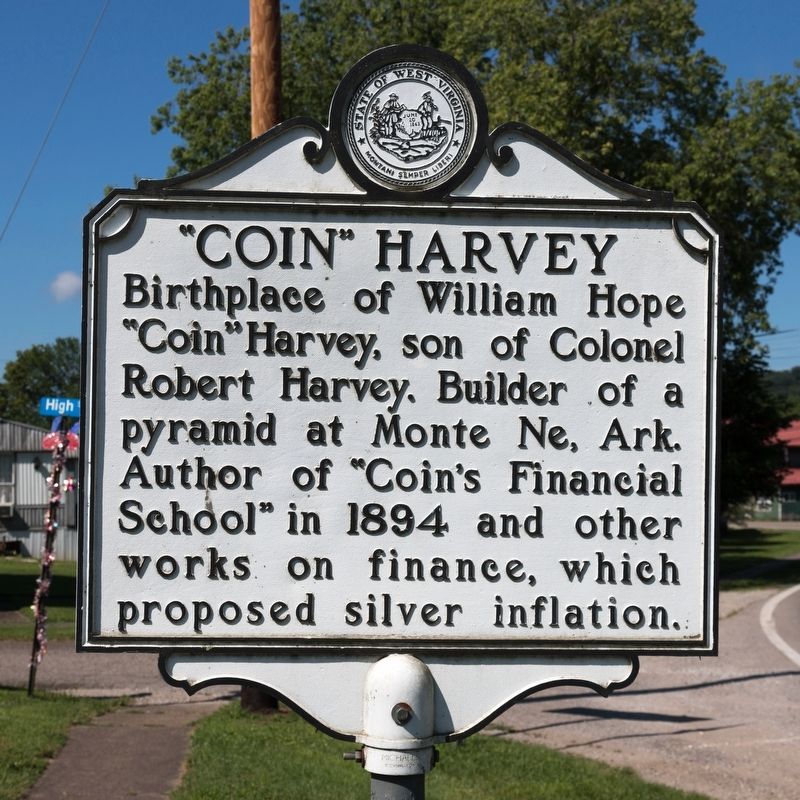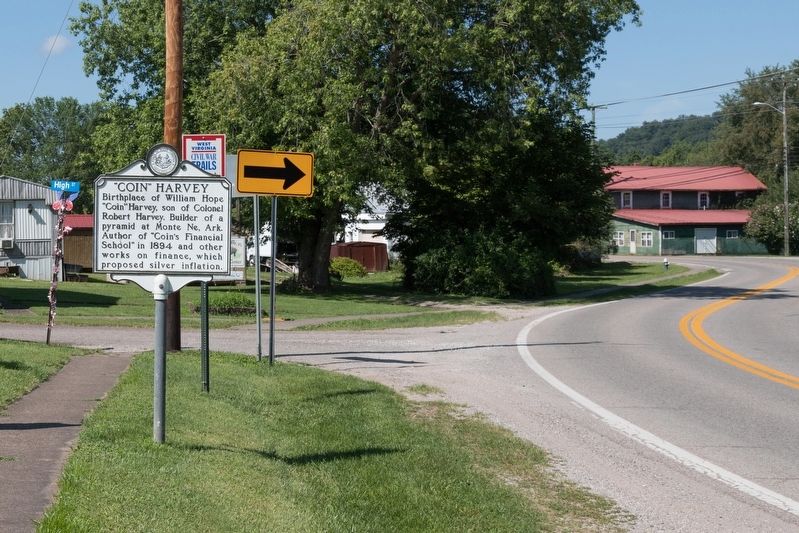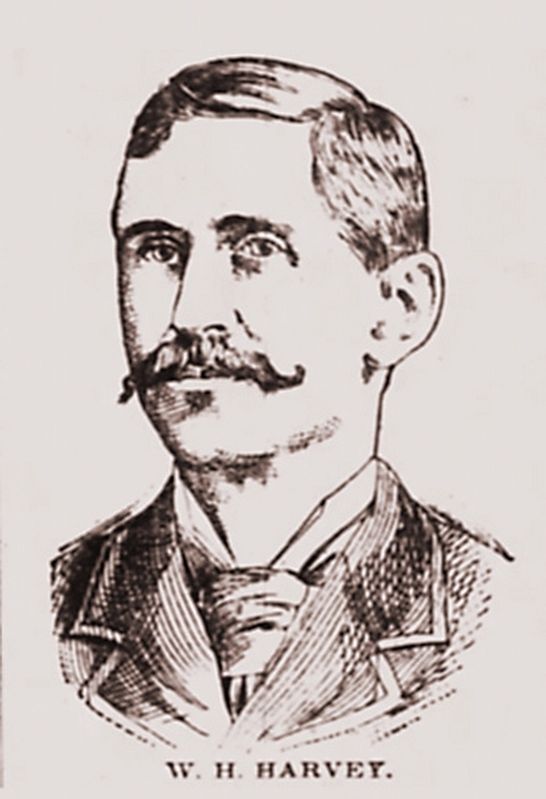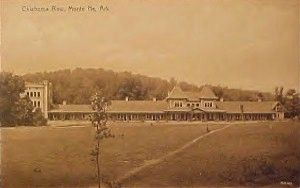Buffalo in Putnam County, West Virginia — The American South (Appalachia)
“Lawnvale” / “Coin” Harvey
Lawnvale. One mile north, home of Dr. T. C. Atkeson, head of Grange for many years. Dean of the West Virginia College of Agriculture and author of many works on agriculture. For nearly 50 years, Atkeson was a leader among farmers of America.
Coin Harvey. Birthplace of William Hope “Coin” Harvey, son of Colonel Robert Harvey. Builder of a pyramid at Monte Ne, Arkansas. Author of “Coin’s Financial School” in 1894 and other works on finance, which proposed silver inflation.
Topics and series. This historical marker is listed in these topic lists: Agriculture • Arts, Letters, Music • Education • Industry & Commerce. In addition, it is included in the West Virginia Archives and History series list. A significant historical year for this entry is 1894.
Location. 38° 37.061′ N, 81° 58.844′ W. Marker is in Buffalo, West Virginia, in Putnam County. Touch for map. Marker is in this post office area: Buffalo WV 25033, United States of America. Touch for directions.
Other nearby markers. At least 8 other markers are within 3 miles of this marker, measured as the crow flies. Buffalo Academy (here, next to this marker); Historic Town of Buffalo (here, next to this marker); Raiders in Buffalo (within shouting distance of this marker); Buffalo Presbyterian Church (within shouting distance of this marker); Battle of Atkenson’s Gate (approx. 2.2 miles away); Indian Village / Excavations (approx. 2.3 miles away); Putnam County / Mason County (approx. 2.3 miles away); General McCausland (approx. 2.8 miles away). Touch for a list and map of all markers in Buffalo.
Also see . . .
1. Lawnvale in The WPA Guide to West Virginia. 1948 book by the “WPA Writer’s Project.” Amazon Kindle edition reprinted 2013 by Trinity University Press. Excerpt:
LAWNVALE (R), 37.3 m., a white farmhouse ( private ), with green shutters, and a dozen oddly assorted outbuildings are screened by a copse of oak and white pine. Lawnvale was the home of Dr. T. C. Atkeson (1852–1936), agriculturalist and educator, and the birthplace of his daughter, Mary Meek Atkeson, educator, author, and lecturer on country life.(Submitted on July 30, 2019.)
2. Wikipedia entry for William Hope Harvey. Excerpt:Populist political activist(Submitted on July 30, 2019.)
It was during his time in Colorado that Harvey became exposed to the idea that the demonetization of silver through passage of the Coinage Act of 1873 had extremely deleterious economic effects on the American economy, including the multiyear Long Depression of 1873 to 1879, the Depression of 1882 to 1885, recessions in 1887 and 1890, and the Panic of 1893. This entire era was marked by general deflation, tight money supply, mass bankruptcies, and unemployment, which many attributed to a lack of sufficient circulating currency to support the needs of industry and commerce.
Harvey became a leading advocate of a return to the unlimited coinage of silver into money, and in 1894 authored a popular pamphlet to advance this policy, Coin’s Financial School, which became an important ideological document of the nascent Populist movement. The massive circulation of this work made Harvey a public figure as one of the leading free silver advocates in America.
3. Wikipedia entry for Monte Ne. Excerpt:Monte Ne is an area in the Ozark hills of the White River valley east of Rogers, on the edge of Beaver Lake, in the US state of Arkansas. From 1901 until the mid-1930s the area was a health resort and ambitious planned community. It was owned and operated by William Hope Harvey, a financial theorist and one-time U.S. Presidential nominee. Two of its hotels, “Missouri Row” and “Oklahoma Row,” were the largest log buildings in the world.(Submitted on July 30, 2019.)
...
The Monte Ne resort was not a financial success, due in part to Harvey’s failure to adequately manage the resort’s funds. All ventures associated with Harvey’s original Monte Ne concept either were never completed or experienced bankruptcy ...
...
By 1910, Harvey was facing serious setbacks. ... Harvey had begun reasoning that the end of civilization was at hand. In February 1920, he published Common Sense,in which Harvey announced his intention to leave a message for the future in the form of a pyramid. ... The total height would be 130 feet (40 m). In the pedestal there would be 300 square feet of floor space. Harvey’s books, explaining 20th-century civilization, as well as a world globe, a bible, encyclopedias, and newspapers, were to be placed inside two vaults and hermetically sealed in glass.
...
Following the Egyptian mania that gripped the country after the discovery of King Tut’s tomb in 1922, Harvey’s Pyramid project sparked a lot of interest and was widely reported throughout the U.S. Tens of thousands of people came to Monte Ne during the 1920s to see its progress. Harvey continued to raise funds from events held at the amphitheater, such as conventions.
...
The estimated cost of the Pyramid itself was $75,000, but Harvey exhausted his funds on construction of the amphitheater. The stock market crash of 1929 ended all construction. In a last-ditch effort to save the project, Harvey sent letters to wealthy men asking for funds to complete the project. In his letters he explained that civilization was dying and that only rich men, like the intended readers, could save it, if they could send money for his pyramid. Despite the fact that Harvey claimed his correspondence was “the most important letter ever written” he received no replies and the pyramid was never built. All that remains of the project is a retaining wall and the amphitheater that are under the waters of Beaver Lake most ofthe time.
Credits. This page was last revised on January 9, 2020. It was originally submitted on July 30, 2019, by J. J. Prats of Powell, Ohio. This page has been viewed 280 times since then and 29 times this year. Photos: 1, 2, 3, 4, 5. submitted on July 30, 2019, by J. J. Prats of Powell, Ohio.




